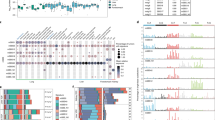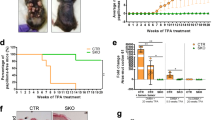Abstract
CURRENT understanding of the pathogenesis of neoplasia rests principally on the demonstration1–3 that the induction of carcinomas of mouse skin by hydrocarbons can be separated into at least two stages. There is evidence of similar stages in the natural history of carcinogenesis of nonepidermal tissues4–7. For example, Peraino et al.6 have shown that short term feeding of acetylaminofluorene to rats followed by a long term diet containing 0.05% phenobarbital results in 100% incidence of hepatomas, whereas animals receiving acetylaminofluorene and no phenobarbital developed 10 times fewer hepatocarcinomas. Peraino's procedure and that of Kitagawa et al.7, who fed rats azo dye followed by phenobarbital, required that the carcinogen be fed to the rats for 3–8 weeks. On the other hand, Scherer and Emmelot8 have shown that a single large dose of diethylnitrosamine given to rats within 24 h of partial hepatectomy can induce hepatocellular carcinomas, whereas low doses (< 30 mg kg−1), given in the same way, give rise only to small foci of cells deficient in ATPase, comparable with those described earlier9,10. Further, Solt and Farber11 have reported that a single dose of diethylnitrosamine followed by acetylaminofluorene and partial hepatectomy rapidly produces foci containing γ-glutamyl transpeptidase, in contrast to the situation in normal liver which exhibits no histochemical activity of that enzyme. By combining the procedure of Scherer and Emmelot8 with that of Peraino et al.6, we have been able to distinguish clearly between two stages in the genesis of liver cancer in rats.
This is a preview of subscription content, access via your institution
Access options
Subscribe to this journal
Receive 51 print issues and online access
$199.00 per year
only $3.90 per issue
Buy this article
- Purchase on Springer Link
- Instant access to full article PDF
Prices may be subject to local taxes which are calculated during checkout
Similar content being viewed by others
References
Berenblum, I. & Shubik, P. Br. J. Cancer 1, 379–395 (1947).
Berenblum, I. & Shubik, P. Br. J. Cancer 3, 109–119 (1949).
Boutwell, R. K. Crit. Rev. Toxicol. 2, 419–443 (1974).
Cole, L. J. & Nowell, P. C. Science 150, 1782–1786 (1965).
Hicks, R. M., Wakefield, S. T. J. & Chowaniec, J. Nature 243, 347–349 (1969).
Peraino, C., Fry, R. J. M., Staffeldt, E. & Kisieleski, W. E. Cancer Res. 33, 2701–2705 (1973).
Kimura, N. T., Kanematsu, T. & Baba, T. Z. Krebsforsch 87, 266–275 (1976).
Scherer, E. & Emmelot, P. Eur. J. Cancer 11, 689–696 (1975).
Rabes, H. M., Scholze, P. & Jantsch, B. Cancer Res. 32, 2577–2586 (1972).
Friedrich-Freksa, A., Gossner, W. & Borner, P. Z. Krebsforsch 72, 226–241 (1969).
Solt, D. & Farber, E. Nature 263, 701–703 (1976).
Rutenberg, A. M. et al. J. Histochem. Cytochem. 17, 517–526 (1969).
Scherer, E. & Emmelot, P. Eur. J. Cancer 11, 145–153 (1975).
Scherer, E. & Hoffmann, M. Eur. J. Cancer 7, 369–371 (1971).
Pilot, H. C., Shires, T., Moore, E. & Garrett, C. T. in Molecular Biology of Cancer (ed. Busch, H.) 523–534 (Academic, New York, 1974).
Kitagawa, T. & Pitot, H. C. Cancer Res. 35, 1075–1084 (1975).
Murray, R. W., Khairallah, L., Ragland, W. & Pitot, H. C. Int. Rev. Path. 6, 229–260 (1968).
Fiala, S., Mohindru, A., Ketterig, W. G., Fiala, A. E. & Morris, H. P. J. natn. Cancer Inst. 57, 591–599 (1976).
Pugh, T. D. & Goldfarb, S. Proc. Am. Ass. Cancer Res. 18, 130 (1977).
Scherer, E., Hoffmann, M., Emmelot, P. & Friedrick-Freksa, H. J. natn. Cancer Inst. 49, 93–106 (1972).
Author information
Authors and Affiliations
Rights and permissions
About this article
Cite this article
PITOT, H., BARSNESS, L., GOLDSWORTHY, T. et al. Biochemical characterisation of stages of hepatocarcinogenesis after a single dose of diethylnitrosamine. Nature 271, 456–458 (1978). https://doi.org/10.1038/271456a0
Received:
Accepted:
Issue Date:
DOI: https://doi.org/10.1038/271456a0
This article is cited by
-
Therapeutic potential of functionalized siRNA nanoparticles on regression of liver cancer in experimental mice
Scientific Reports (2019)
-
Serum histamine and acetylcholine variations as new noninvasive biochemical markers in staging of experimental hepatocellular carcinoma
Clinical and Experimental Medicine (2019)
-
Studies of tamoxifen as a promoter of hepatocarcinogenesis in female Fischer F344 rats
Breast Cancer Research and Treatment (1994)
Comments
By submitting a comment you agree to abide by our Terms and Community Guidelines. If you find something abusive or that does not comply with our terms or guidelines please flag it as inappropriate.



